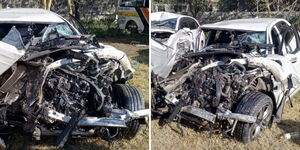In April 2023, the Institution of Engineers of Kenya (IEK) revealed that only 15% of the buildings across the nation were safe, leaving the majority at risk of potential collapse, shedding light on a critical issue within the construction industry.
Certified building contractor Jonathan Kyalo provided valuable insight into the problem, emphasizing that a significant factor behind building failures in Kenya was the widespread issue of weak columns in construction.
His expertise highlighted a structural concern that had far-reaching implications for building safety.
“Columns are an essential part of any building, providing support and stability. However, when columns fail, they can cause a building to collapse,” he told Kenyans.co.ke.
Joan Kanyi, a seasoned construction manager, further underscored the gravity of this issue by voicing similar concerns.
In a statement, the construction manager observed that many construction players were cutting corners. She stressed that columns contribute greatly to the strength of a building.
According to the expert, columns should have sufficient bars and the appropriate diameter to ensure they serve their purpose accordingly.
She emphasized the importance of firm formwork to securely contain the compacted concrete, along with ensuring the correct mix ratio for concrete. These factors play a pivotal role in preventing column failure.
Various factors can contribute to column failure, including;
Poor design
She emphasized the importance of firm formwork to securely contain the compacted concrete, along with ensuring the correct mix ratio for concrete. These factors play a pivotal role in preventing column failure.
Various factors can contribute to column failure, including:
Insufficiently designed columns, unable to bear their expected loads, are prone to failure. Such failures may result from design flaws or unanticipated shifts in a building's purpose or occupancy as envisioned by the designers.
Faulty construction
Even if columns are designed properly, they can fail if they are not placed correctly.
“This usually happens when homeowners go for cheap contractors who go ahead to use substandard materials or make changes to the construction that had not been approved by engineers,” Kyalo explained.
Deterioration
With time, columns can undergo deterioration caused by factors such as corrosion or environmental influences. This degradation can lead to a weakening of the columns and increase the likelihood of failure.
Accidental Damage
Columns are susceptible to damage from accidents, including fires, explosions, or vehicle impacts, which can result in their weakening and a higher risk of failure.
A column's failure can trigger a domino effect, culminating in the entire building's collapse. This phenomenon, termed progressive collapse, can transpire even when the remaining columns in the structure are structurally sound.
How to Prevent Column Failure
Kyalo highlights various strategies for preventing column failure, including thoughtful column design, material quality, and safety measures.
Designing columns to endure their anticipated loads necessitates a meticulous assessment of the expected loads, materials, and construction methods.
Contractors are encouraged to employ top-tier materials and proven construction techniques, prioritising strength and durability.
Homeowners are urged not to overlook post-construction maintenance and should conduct regular inspections to detect deterioration or damage early on, averting potential failures.
To avert accidental damage, implementing protective safety measures for columns is recommended, such as fireproofing installations and safeguards against vehicle impacts.
Routine inspections by the National Building Inspectorate should also be part of the building's upkeep regimen.
How to Mitigate the Effects of Column Failure
Kyalo advises building contractors and homeowners that apart from preventing column failure, it is also important to mitigate its effects.
This can be achieved through;
Having multiple columns supporting each load so that if one column fails, the others can still support the building.
Contractors can also use special features, such as bracing or shear walls, to help prevent the collapse of the building if a column fails.
“These features can help to distribute the load from the failed column to the other columns, and can help to prevent the building from collapsing,” he explains.
It is also prudent to implement progressive collapse prevention measures to reduce the likelihood of a progressive collapse, even if a column does fail.












